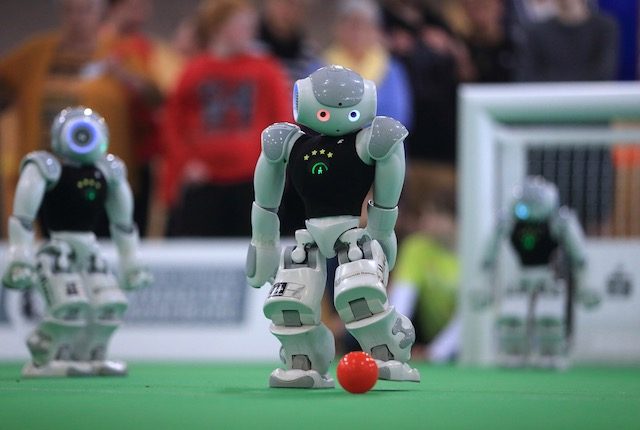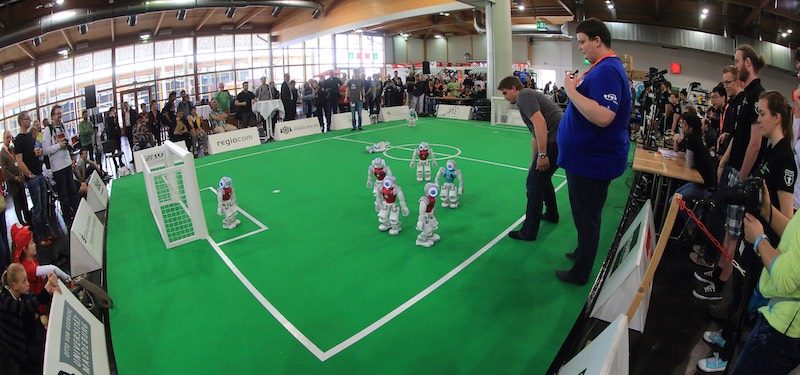SUMMARY
This is AI generated summarization, which may have errors. For context, always refer to the full article.

The creation of robots and various forms of artificial intelligence has always been drawn toward the vision that one day, what we create can best us in order to solve problems that we ourselves cannot solve.
We have seen early signs of this paradigm back in February 1996 when the Deep Blue program defeated the reigning world champion Gary Kasparov in chess. While chess offers a good platform for showcasing computer talent competing against human brain power, it offered little with regards to how computer intelligence can be measured against its interaction with human beings in the physical world.
Enter the RoboCup, an international competition founded in 1997 with the aim of promoting robotics and artificial intelligence research through a publicly appealing platform of soccer. RoboCup, a contraction for Robot Soccer World Cup was created with the ultimate goal of creating fully autonomous humanoid robots that will win a soccer game, complying with FIFA rules, against the most recent winner of the World Cup by the middle of the 21st century. While the task is indeed daunting, short term improvements in this technology may spell out a few leaps for us with respect to improving the technology we use today.
A closer look at a soccer robot system reveals that it is actually comprised of 4 distinct areas of study that are integrated for the robots to function: a vision system, artificial intelligence, wireless communications, and mechanical design.
To give the robots their “vision,” cameras are utilized in two ways – either on board the robot, thus giving it a pair of “eyes,” or above the playing field for a centralized overhead view. Unlike human beings, the computer can only understand images in terms of shape and color. Combining both allows robots to identify objects such as the ball and members of both the opposing team and its own. This awareness also extends to the robots’ position relative to other objects in a given space.

To be able to understand the images produced by the camera, the system normally requires a degree of artificial intelligence. This is the “brain” of the robots. Because the rules insist on robots behaving autonomously (absolutely no human intervention during gameplay), engineers program instructions into them and equip them with pre-set strategies that directly relate to how they behave during the offensive and defensive end of gameplay.
On the back-end, the wireless communication system takes care of the data being processed to allow the robots to react efficiently with the constant movement of the game as it is on-going. It serves as the bridge between the thought and action of the robot as it governs both the input and output of data. By tweaking the wireless communications, engineers are capable of making the robots react faster to given situations and time improvement can dictate the fine line between victory and defeat.
Added to that, the mechanical design of each robot allows for efficiency when it comes to movement and ball control. After all, what good is a smart robot without the hardware that lets it withstand in-game collisions and the heavy wear-and-tear of each contest? Implementing the newest tools and instruments heightens the overall performance and durability of the soccer robots, and also contributes to its aesthetic appeal.
To attain the goal of developing human-like robots that can play soccer with human beings some time in the middle of the 21st century requires a bit more time to become a reality. Further training of experts as well as awaiting the development of newer technology can be resource-consuming yet a necessary focal point.
For the meantime, engineers, scientists and enthusiasts of all forms and crafts are given this avenue to test the newest technology being developed in the robotic world today. This is essential because by doing so, these improvements can make their way into the consumer market, and in effect, promote a better means of living life. As an example, smartphones have greatly benefitted from this as can be seen by the rapid improvement of smartphone cameras and features along with the leap in mobile communication efficiency.
The technology developed has also given rise to automation and autonomous housing appliances as well as more durable products. Such is also true for haptics and haptic technology which has been a growing field in itself in order to investigate our sense of touch and our experience of physical pain.
While the engineers, programmers, and designers toil on, the creation of robots and forms of intelligence that can equate us, or even best us in the things we do will eventually humble us. Robots that play soccer may today be an engineers outlet, but we have to take a closer look at how it is already shaping our lives into the next frontier of tomorrow. – Rappler.com
Add a comment
How does this make you feel?
There are no comments yet. Add your comment to start the conversation.